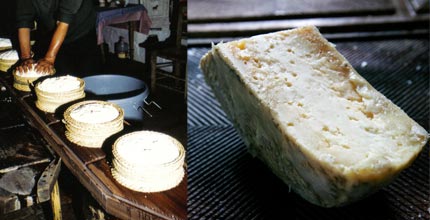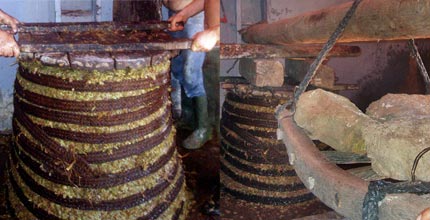The craftsmanship of the area, in general, served as a complement to the primary sector and covered other necessities of daily life when there was not enough economic level or communication possibilities to stock up on manufactured goods, expensive and coming from abroad. Therefore, it was the craftsmanship that could afford an economy based largely on self-sufficiency, without becoming completely autarky and, as traditional knowledge, its manifestations have suffered different fates, depending on their greater or lesser adaptation to a much more open and industrialized economy.

It must be borne in mind that some of the types of crafts to which we are going to refer are already very close to industrial production and that, considering all artisan manifestations in general, we find one of the most important productive sectors of the region, due to the variety of products and the prestige that some of them have acquired, the intense specialization in this field of populations such as Ubrique and, to a lesser extent, the municipalities that surround it, or its relationship with the important cooperative movement generated in the Olvera area.

A continuación se describen algunas de las actividades artesanales más importantes de los municipios donde se desarrollan.
Alcalá del Valle
The main craft activities are: hand embroidery, the bolillo lace, artisanal movable miniatures, the works in enea, (activity declines due to the less and less frequent use of this product).
The artisanal activity of Alcalá has never been a sector of relevance in terms of its impact on the local economy.
Algar
The craft activity is based on leather goods, Bags, Belts, Purses, Etc. Artisan gastronomy based on big game meat can be included in the activity.
Algodonales
Artisan oils and guitars stand out. Other products within the local crafts are: high quality sweets, the saddlery (activity of great tradition in the municipality, of family type and with prospects of empowerment), the manufacture of handmade guitars (the existing workshop sells in various parts of Spain and even exports to France, Belgium, Japan and the U.S.; and its continuity is assured and appears as an activity with greater possibilities of development although business ambition is lacking), joinery (there are several carpentry standing out in a special way for the quality of their furniture, the Cooperative "Arenal"), leather goods, performed mainly by women of 18 to 35 years, is done illegally.
Border Arches
The manufacture of blankets stands out (using natural materials) and the ceramics of Jédula.
Benaocaz
We will point out the following activities: Cork (chairs and tables), leather goods (leather goods), the “crochet” and general point (Bedspreads, Tablecloths, Etc) and traditional carpentry of agricultural instruments (yoke, plough, etc.).
Bornos
We point out the works in esparto, wicker, the palm, the enea, olive rods, the cane, wood and leather. The tools manufactured have had a close relationship with the prevailing economic activity in this area, agriculture. The cerones, the capacha, hats and palm belts, were necessary complements to cope more easily with the working day. For the construction of typically rural houses such as huts, palm was used in the same way. Objects intended for the home and purely artisans are the carpet, the blinds and the different baskets (for bread, eggs, etc.). Another craft activity to consider, is screen printing. Even if it is collected as an industrial activity, the workshop exists in the locality works with artisanal machines that allow it to develop the required works.
The Forest
The construction of furniture stands out as fundamental craft activities, sausages and the leather sector.
Hold on
Handicrafts represent an activity of little importance in the local economy, However, pastries and oils can be highlighted. While the latter, must be considered as an industrial activity, the production of oils in Espera can also be considered as an activity of great tradition bordering on the artisanal factor.
The Gastor
The main craftsmanship is represented by esparto utensils and belongings, palm and cane, as well as rod baskets. The most representative items are espadrilles, Carpets, Baskets, bottles, Hats, gates, Brooms, Bags, Etc. Special mention deserves the artisanal construction of the "Gaita Gastoreña". Wind musical instrument that comes from the "Chirimia Arabe", formerly used for communication between shepherds. Last, highlight the great tradition among the women of the town in terms of the realization of "crochet point", manufacturing quilts, Curtains, tablecloths and other high quality work.
Grazalema
The main artisan activities are: Filigree basketry, cork articles (practically disappeared, only carried out by older people), copper crafts in Benamahoma (people who were important in the manufacture of objects of decoration and domestic use in the copper industry), and textile craftsmanship. Artisanal pastries, with distribution outside the town and leather goods without great tradition, are other craft activities developed. Despite not having an important tradition in the town, artisanal ceramics are gaining an important boom in Grazalema and Benamahoma, as well as the craftsmanship of wood
Olvera
There are two activities of an artisanal nature; forging work and the manufacture of wooden furniture. The manufacture of pavements derived from cement with decoration and handmade motifs should also be considered.. It is also known, the production of sausages and cheeses.
King's Meadow
The main craft activities are focused on leather goods, carpentry and various agri-food products (manufacture of sausages and other meat derivatives in an artisanal way). There is a great tradition in wood craftsmanship in this town.
Puerto Serrano
Its main craft activities are, basketry, the construction of coupling trolleys and articles of leather, highlighting the manufacture of botos.
Setenil de las Bodegas
Craftsmanship has as main activities: ornate craftsmanship, restoration and polychrome of objects. Restorations of furniture and antique objects are also carried out, furniture decoration, polychrome of objects, decoration of murals and moldings for interior decoration, as well as the commercialization of objects and furniture. It should also be noted the craftsmanship of ceramics, the carpentry of the furniture or the work of esparto and brass.
Torre-Alháquime
The most important craft activity is confectionery, highlighting the production of "matalauva", special for pastry production and other dishes. Artisanal meat industries should also be targeted (manufacture of sausages and sausages).
Ubrique
As far as this locality is concerned, the main craft activity, leather goods, it is at the same time the engine of the local economy, although it must be included within the industrial process, it is still possible to classify the activity as artisanal manufacturing by some methods used in its production.
Villaluenga del Rosario
The main craft activities are: leather goods, work on palms and cork, the manufacture of mosaics and the manufacture of sausages, Sausages, goat cheeses and confectionery products (in an artisanal way).
Villamartín
Presents as main craft activities the leather goods, ceramics, the forge, basketry and wood carvings.
Zahara de la Sierra
The main craft activities focus on basketry (baskets made with olive rods, cane and esparto), and in crochet work, shawls and bedspreads.


